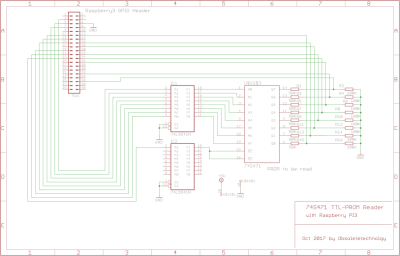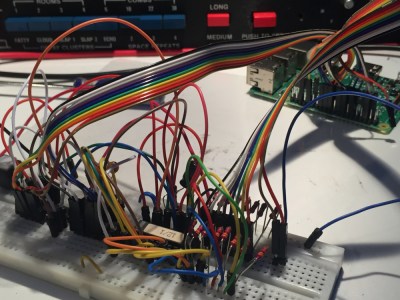The Ursa Major Space Station SST282 is a dinosaur of a digital reverb. Okay, so maybe 1978 isn’t ancient yet, but it is getting to the point where one has to worry about the possibility of component failure. At least that’s what [Obsoletetechnology] thought when they created a backup of its memory contents.
As can be seen from some of Hackaday’s previous articles, a part does not have to be an older one to fail. However, there is no such thing as being too paranoid when it comes to older parts reaching their lifetime. Especially when there is valuable memory involved. Each bit of PROM memory is locked by a fuse on its location grid to store permanent data. To be able to read this and collect the respective data, a Raspberry Pi 3 PROM reader was created.

The SST282 uses 3 TTL-level 74xx series Schottky PROM memories on board that hold RAM lookup tables. In the case that these failed, all of the subsequent information would be lost since there are no surviving memory dumps online. Fortunately we are interested only in gathering their contents, so the PROM reader schematic is fairly rudimentary. The chip’s address and data buses connect to a Pi’s GPIO header, and the only other thing to note is a 74LS541 TTL level shifter that converts the Pi’s 3.3V output to the PROM’s 5V TTL level.

The whole is controlled by a pair of Python scripts that configure the ports with the Pi, and then repeatedly cycle through the PROM’s complete address range and store each memory location’s data value to a file.
[Obsoletetechnology] has graciously provided the download for their Python script along with the corresponding data dumps that were found. If you still have one of these bad boys, consider trying out this hack so you can rest at ease as you play with those vintage audio effects.















PROM seems rather reliable. EPROMs, on the other hand, have a lifetime that is coming up soon. I’ve already had an engine computer fail with configuration bits slowly rotting from 0 to 1. No idea how many bits flipped before one of the bits that recorded the list of legitimate keys failed.
I believe this is how the Counsel of Robots became corrupt…
Reminds me of the Eventide Harmonizer…I had one…perfect for pitch shift AND delay.
seems like a job for an arduino to be honest, certainly given the age of the device, a lowly ATMega would be plenty .. they used what they had on hand i guess ..
i imagine the timing restrictions were also pretty lax, or can the python rpi GPIO module guarantee certain timing when bit-banging in a python script like this ?
I’m sure there’s no way the Python script could be too fast i.e write the address lines (input to the PROM), then read it too soon before the data lines (output from the PROM) had stabilised. Too slow is no problem. The PROM will output the byte requested by the address lines as long as it has power, so there’s no lower limit on timing, just an upper limit.
I started in industry early enough to work with these PROMs. Fuse PROMs were notorious for the fuses “regrowing” through migration and de-programming bits, which could not then be re-blown because the resistance of the regrowth was too high. They were far less reliable than charge storage EPROMs which succeeded them. I had several of these things fail on me when they were still in current use. Backing them up is a long overdue precaution.
For a while, I repaired old Arcade boards, and these often had old PROMs as well. And almost invariably, the pins of the PROMs would have blackened from oxidisation. None of the other chips would have any issues, just the PROMs. The strangest thing; why it only happened to PROMs. I wonder if the PROM technology has something to do with it.
RetepV
I collect old arcade boards and have seen the same problems on some of the custom IC’s (galaga, defender(blitter)). I work in the silicon industry. This problem is not specific to prom technology itself. It’s the type of lead frame surface preparation/protective coating used. The lead frame is cropped and formed in manufacturing to become the pins. Several types of parts from many vendors back then have this problem. The lead frames used to be a variety of alloys with different plating/coatings for solder-ability.
They talk about it here , http://www.er-emergency.com/wp-content/uploads/2012/02/A-review-of-Corrosion-and-environmental-effects-on-electronics.pdf
a nice report with some balck-pin pics is here http://www.calce.umd.edu/TSFA/calce_has_shown.pdf
Without knowledge of the piece of equipment in question, this post was a beast to try and wrap my head around. I can’t tell you how long I was stuck trying to figure out what this had to do with the Space Station,
Yeah, no mention of whether it was Skylab, Salyut, Mir, ISS…
And they had a Prom on one of them? Who were the Prom Queen and King? I found nothing in the Fashion press about the formal dress used (tuxedos, evening gowns)!